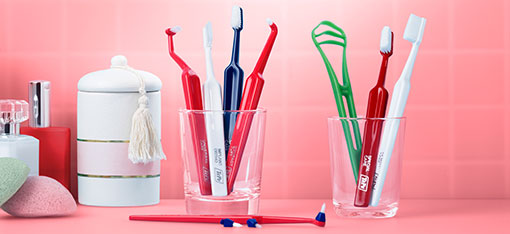Your Gums
Gum Disease
Gingivitis can be prevented
You can do a lot yourself to prevent and reverse periodontal disease through proper oral hygiene. Brush your teeth twice a day. Once a day, also clean between the teeth using interdental brushes, Mini Flosser or dental floss. A special toothbrush for cleaning hard-to-reach areas may also be needed.
Ask your dentist or dental hygienist for advice and instruction.
Gingivitis
Gingivitis and periodontitis, also known as gum disease, is very common but can be prevented through good oral hygiene.
Gingivitis = gum inflammation
Periodontitis = loss of the bone that support the teeth
What is gum inflammation (gingivitis)?
Healthy gums are pale, pink and firm. The gum tissue acts as a barrier and fits firmly around the tooth. Healthy gums do not bleed when you brush or clean between your teeth. Red, swollen and bleeding gums are a sign of gingivitis (gum inflammation) and if left untreated, can lead to periodontitis, loss of bone around the tooth. Around 40% of adults suffer from periodontitis – often without knowing it. Gingivitis and periodontitis can develop slowly and often without pain. The sooner the diseases are diagnosed and treated, the better.
What causes gingivitis?
A sticky film called dental plaque constantly forms on your teeth. If you don't clean properly, plaque will be left behind, especially between the teeth and along the gum line. When plaque accumulates in these areas, it causes inflamed gums (gingivitis), with redness and swelling. Inflamed gums may bleed when you clean your teeth.
Prevent gum inflammation
If you suspect that you have gum inflammation, contact your dental professional. Taking note of the advice that your dental practitioner offers is of utmost importance for a successful result, even after treatment is completed. Regular check-ups in combination with your own home care are crucial to prevent the problems from returning.
Signs of gingivitis
- Red and swollen gums
- Bleeding when brushing
Healthy Gums
Gum Inflammation
Periodontitis
If plaque is not removed, it continues to grow in between the tooth and gums. On the root surface of the tooth, the plaque can harden into tartar which has a rough surface where new bacteria can attach with ease . These bacteria contribute to the loss of bone around the tooth. The gum inflammation has developed into periodontitis.
2. Aging Population
• Learn about TePe as a company with a brief introduction of TePe’s product portfolio
• Discuss the importance of oral health for the aging population
• Explore suitable TePe products for the aging population
• Discuss resources to use chairside with patients and how to access products
3. Children's Teeth
• Learn about TePe as a company with a brief introduction of TePe’s product portfolio
• Discuss the importance of oral health for children
• Explore suitable TePe products for children
• Discuss resources to use chairside with patients and how to access products
4. Orthodontic Care
• Learn about TePe as a company with a brief introduction of TePe’s product portfolio
• Discuss the importance of oral health during orthodontic treatment
• Explore suitable TePe products during orthodontic treatment
• Discuss resources to use chairside with patients and how to access products
5. Sustainability
• Learn about TePe as a company with a brief introduction of TePe’s product portfolio
• Explore what sustainability means at TePe
• Understand TePe’s journey to sustainable change
• Summarize the benefits of pursuing sustainable products










